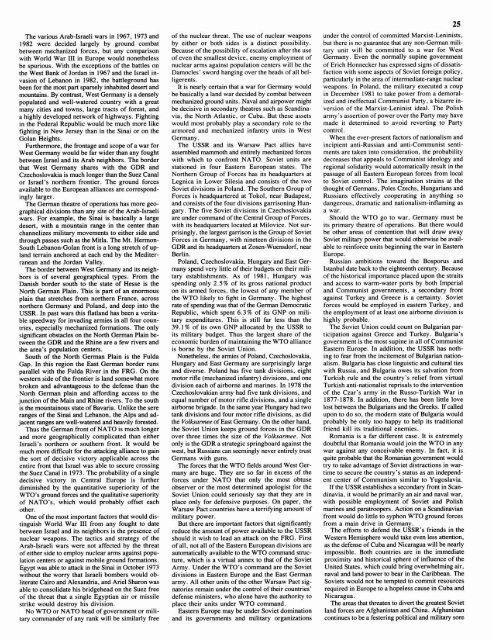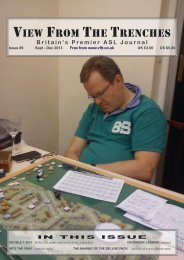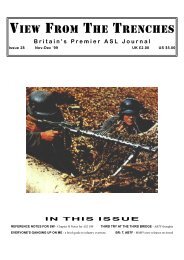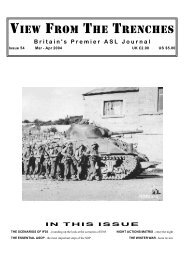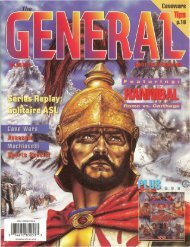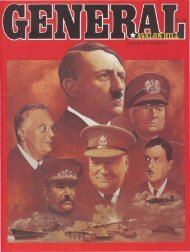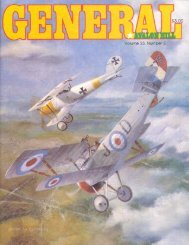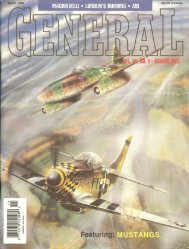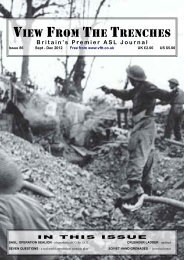You also want an ePaper? Increase the reach of your titles
YUMPU automatically turns print PDFs into web optimized ePapers that Google loves.
<strong>The</strong> various Arab-Israeli wars in 1967, 1973 and<br />
1982 were decided largely by ground combat<br />
between mechanized forces, but any comparison<br />
with World War I11 in Europe would nonetheless<br />
be spurious. With the exceptions of the battles on<br />
the West Bank of Jordan in 1967 and the Israel in-<br />
vasion of Lebanon in 1982, the battleground has<br />
been for the most part sparsely inhabited desert and<br />
mountains. By contrast, West Germany is a densely<br />
populated and well-watered country with a great<br />
many cities and towns, large tracts of forest, and<br />
a highly developed network of highways. Fighting<br />
in the Federal Republic would be much more like<br />
fighting in New Jersey than in the Sinai or on the<br />
Golan Heights.<br />
Furthermore, the frontage and scope of a war for<br />
West Germany would be far wider than any fought<br />
between Israel and its Arab neighbors. <strong>The</strong> border<br />
that West Germany shares with the GDR and<br />
Czechoslovakia is much longer than the Suez Canal<br />
or Israel's northern frontier. <strong>The</strong> ground forces<br />
available to the European alliances are correspond-<br />
ingly larger.<br />
<strong>The</strong> German theatre of operations has more geo-<br />
graphical divisions than any site of the Arab-Israeli<br />
wars. For example, the Sinai is basically a large<br />
desert, with a mountain range in the center than<br />
channelizes military movements to either side and<br />
through passes such as the Mitla. <strong>The</strong> Mt. Hermon-<br />
South Lebanon-Golan front is a long stretch of up-<br />
land terrain anchored at each end by the Mediter-<br />
ranean and the Jordan Valley.<br />
<strong>The</strong> border between West Germany and its neigh-<br />
bors is of several geographical types. From the<br />
Danish border south to the state of Hesse is the<br />
<strong>No</strong>rth German Plain. This is part of an enormous<br />
plain that stretches from northern France, across<br />
northern Germany and Poland, and deep into the<br />
USSR. In past wars this flatland has been a verita-<br />
ble speedway for invading armies in all four coun-<br />
tries, especially mechanized formations. <strong>The</strong> only<br />
significant obstacles on the <strong>No</strong>rth German Plain be-<br />
tween the GDR and the Rhine are a few rivers and<br />
the area's population centers.<br />
South of the <strong>No</strong>rth Geman Plain is the Fulda<br />
Gap. In this region the East German border runs<br />
parallel with the Fulda River in the FRG. On the<br />
western side of the frontier is land somewhat more<br />
broken and advantageous to the defense than the<br />
<strong>No</strong>rth German plain and affording access to the<br />
junction of the Main and Rhine rivers. To the south<br />
is the mountainous state of Bavaria. Unlike the sere<br />
ranges of the Sinai and Lebanon, the Alps and ad-<br />
jacent ranges are well-watered and heavily forested.<br />
Thus the German front of NATO is much longer<br />
and more geographically complicated than either<br />
Israeli's northern or southern front. It would be<br />
much more difficult for the attacking alliance to gain<br />
the sort of decisive victory applicable across the<br />
entire front that Israel was able to secure crossing<br />
the Suez Canal in 1973. <strong>The</strong> probability of a single<br />
decisive victory in Central Europe is further<br />
diminished by the quantitative superiority of the<br />
WTO's ground forces and the qualitative superiority<br />
of NATO's, which would probably offset each<br />
other.<br />
One of the most important factors that would dis-<br />
tinguish World War I11 from any fought to date<br />
between Israel and its neighbors is the presence of<br />
nuclear weapons. <strong>The</strong> tactics and strategy of the<br />
Arab-Israeli wars were not affected by the threat<br />
of either side to employ nuclear arms against popu-<br />
lation centers or against mobile ground formations.<br />
Egypt was able to attack in the Sinai in October 1973<br />
without the worry that Israeli bombers would ob-<br />
literate Cairo and Alexandria, and Ariel Sharon was<br />
able to consolidate his bridgehead on the Suez free<br />
of the threat that a single Egyptian air or missile<br />
strike would destroy his division.<br />
<strong>No</strong> WTO or NATO head of government or mili-<br />
tary commander of any rank will be similarly free<br />
of the nuclear threat. <strong>The</strong> use of nuclear weapons<br />
by either or both sides is a distinct possibility.<br />
Because of the possibility of escalation after the use<br />
of even the smallest device, enemy employment of<br />
nuclear arms against population centers will be the<br />
Damocles' sword hanging over the heads of all bel-<br />
ligerents.<br />
It is nearly certain that a war for Germany would<br />
be basically a land war decided by combat between<br />
mechanized ground units. Naval and airpower might<br />
be decisive in secondary theatres such as Scandina-<br />
via, the <strong>No</strong>rth Atlantic, or Cuba. But these assets<br />
would most probably play a secondary role to the<br />
armored and mechanized infantry units in West<br />
Germany.<br />
<strong>The</strong> USSR and its Warsaw Pact allies have<br />
assembled mammoth and entirely mechanized forces<br />
with which to confront NATO. Soviet units are<br />
stationed in four Eastern European states. <strong>The</strong><br />
<strong>No</strong>rthern Group of Forces has its headquarters at<br />
Legnica in Lower Silesia and consists of the two<br />
Soviet divisions in Poland. <strong>The</strong> Southern Group of<br />
Forces is headquartered at Tokol, near Budapest,<br />
and consists of the four divisions garrisoning Hun-<br />
gary. <strong>The</strong> five Soviet divisions in Czechoslovakia<br />
are under command of the Central Group of Forces,<br />
with its headquarters located at Milovice. <strong>No</strong>t sur-<br />
prisingly, the largest garrison is the Group of Soviet<br />
Forces in Germany, with nineteen divisions in the<br />
GDR and its headquarters at Zosen-Wuensdorf, near<br />
Berlin.<br />
Poland, Czechoslovakia, Hungary and East Ger-<br />
many spend very little of their budgets on their mili-<br />
tary establishments. As of 1981, Hungary was<br />
spending only 2.5% of its gross national product<br />
on its armed forces, the lowest of any member of<br />
the WTO likely to fight in Germany. <strong>The</strong> highest<br />
rate of spending was that of the German Democratic<br />
Republic, which spent 6.3% of its GNP on mili-<br />
tary expenditures. This is still far less than the<br />
39.1 % of its own GNP allocated by the USSR to<br />
its military budget. Thus the largest share of the<br />
economic burden of maintaining the WTO alliance<br />
is borne by the Soviet Union.<br />
<strong>No</strong>netheless, the armies of Poland, Czechoslovakia,<br />
Hungary and East Germany are surprisingly large<br />
and diverse. Poland has five tank divisions, eight<br />
motor rifle (mechanized infantry) divisions, and one<br />
division each of airborne and marines. In 1978 the<br />
Czechoslovakian army had five tank divisions, and<br />
equal number of motor rifle divisions, and a single<br />
airborne brigade. In the same year Hungary had two<br />
tank divisions and four motor rifle divisions, as did<br />
the <strong>Vol</strong>harmee of East Germany. On the other hand,<br />
the Soviet Union keeps ground forces in the GDR<br />
over three times the size of the <strong>Vol</strong>ksarmee. <strong>No</strong>t<br />
only is the GDR a strategic springboard against the<br />
west, but Russians can seemingly never entirely trust<br />
Germans with guns.<br />
<strong>The</strong> forces that the WTO fields around West Ger-<br />
many are huge. <strong>The</strong>y are so far in excess of the<br />
forces under NATO that only the most obtuse<br />
observer or the most determined apologist for the<br />
Soviet Union could seriously say that they are in<br />
place only for defensive purposes. On paper, the<br />
Warsaw Pact countries have a terrifying amount of<br />
military power.<br />
But there are important factors that significantly<br />
reduce the amount of power available to the USSR<br />
should it wish to lead an attack on the FRG. First<br />
of all, not all of the Eastern European divisions are<br />
automatically available to the WTO command struc-<br />
ture, which is a virtual annex to that of the Soviet<br />
Army. Under the WTO's command are the Soviet<br />
divisions in Eastern Europe and the East German<br />
army. All other units of the other Warsaw Pact sig-<br />
natories remain under the control of their countries'<br />
defense ministers, who alone have the authority to<br />
place their units under WTO command.<br />
Eastern Europe may be under Soviet domination<br />
and its governments and military organizations<br />
under the control of committed Marxist-Leninists,<br />
but there is no guarantee that any non-German mili-<br />
tary unit will be committed to a war for West<br />
Germany. Even the normally supine government<br />
of Erich Honnecker has expressed signs of dissatis-<br />
faction with some aspects of Soviet foreign policy,<br />
particularly in the area of intermediate-range nuclear<br />
weapons. In Poland, the military executed a coup<br />
in December 1981 to take power from a demoral-<br />
ized and ineffectual Communist Party, a bizarre in-<br />
version of the Marxist-Leninist ideal. <strong>The</strong> Polish<br />
army's assertion of power over the Party may have<br />
made it determined to avoid reverting to Party<br />
control.<br />
When the ever-present factors of nationalism and<br />
incipient anti-Russian and anti-Communist senti-<br />
ments are taken into consideration, the probability<br />
decreases that appeals to Communist ideology and<br />
regional solidarity would automatically result in the<br />
passage of all Eastern European forces from local<br />
to Soviet control. <strong>The</strong> imagination strains at the<br />
thought of Germans, Poles Czechs, Hungarians and<br />
Russians effectively cooperating in anything so<br />
dangerous, dramatic and nationalism-inflaming as<br />
a war.<br />
Should the WTO go to war, Germany must be<br />
its primary theatre of operations. But there would<br />
be other areas of contention that will draw away<br />
Soviet military power that would otherwise be avail-<br />
able to reinforce units beginning the war in Eastern<br />
Europe.<br />
Russian ambitions toward the Bosporus and<br />
Istanbul date back to the eighteenth century. Because<br />
of the historical importance placed upon the straits<br />
and access to warm-water ports by both Imperial<br />
and Communist governments, a secondary front<br />
against Turkey and Greece is a certainty. Soviet<br />
forces would be employed in eastern Turkey, and<br />
the employment of at least one airborne division is<br />
highly probable.<br />
<strong>The</strong> Soviet Union could count on Bulgarian par-<br />
ticipation against Greece and Turkey. Bulgaria's<br />
government is the most supine in all of Communist<br />
Eastern Europe. In addition, the USSR has noth-<br />
ing to fear from the incitement of Bulgarian nation-<br />
alism. Bulgaria has close linguistic and cultural ties<br />
with Russia, and Bulgaria owes its salvation from<br />
Turkish rule and the country's relief from virtual<br />
Turkish anti-nationalist reprisals to the intervention<br />
of the Czar's army in the Russo-Turkish War in<br />
1877-1878. In addition, there has been little love<br />
lost between the Bulgarians and the Greeks. If called<br />
upon to do so, the modern state of Bulgaria would<br />
probably be only too happy to help its traditional<br />
friend kill its traditional enemies.<br />
Romania is a far different case. It is extremely<br />
doubtful that Romania would join the WTO in any<br />
war against any conceivable enemy. In fact, it is<br />
quite probable that the Romanian government would<br />
try to take advantage of Soviet distractions in war-<br />
time to secure the country's status as an independ-<br />
ent center of Communism similar to Yugoslavia.<br />
If the USSR establishes a secondary front in Scan-<br />
dinavia, it would be primarily an air and naval war,<br />
with possible employment of Soviet and Polish<br />
marines and paratroopers. Action on a Scandinavian<br />
front would do little to syphon WTO ground forces<br />
from a main drive in Germany.<br />
<strong>The</strong> efforts to defend the USSR's friends in the<br />
Western Hemisphere would take even less attention,<br />
as the defense of Cuba and Nicaragua will be nearly<br />
impossible. Both countries are in the immediate<br />
proximity and historical sphere of influence of the<br />
United States, which could bring overwhelming air,<br />
naval and land power to bear in the Caribbean. <strong>The</strong><br />
Soviets would not be tempted to commit resources<br />
required in Europe to a hopeless cause in Cuba and<br />
Nicaragua.<br />
<strong>The</strong> areas that threaten to divert the greatest Soviet<br />
land forces are Afghanistan and China. Afghanistan<br />
continues to be a festering political and military sore


